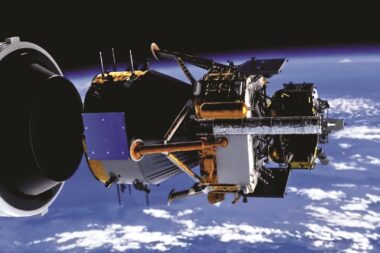Products You May Like
In December, China successfully conducted its first lunar sample retrieval mission. Chang’e-5 landed on the moon, deployed a rover who then dug up various pieces of the lunar surface, then returned to Earth with about 5 pounds of material. This marked the first return of moon rocks in over 40 years.
During the week that Chang’e-5 departed Earth, the giant radio-telescope at Arecibo in Puerto Rico collapsed. One of the supporting cables had failed in August, and another in November, with damage to the main reflector dish. On Dec. 1, the supporting cables on one tower failed completely, causing the structure to collapse.
While there is no reason to think the People’s Republic of China (PRC) had anything to do with the failure of the iconic Arecibo facility, the symbolism of the two events would seem to highlight the steady shift in space prominence. The Chinese Chang’e missions have not done anything the United States has not done previously, but China’s steady persistent efforts have allowed it to build a firm foundation from which to compete with the United States.
This is hardly surprising. For the PRC, space is both substance and symbol.
In terms of substance, the PRC has long seen the aerospace field as a locomotive for broader development of China’s various capabilities. The Chinese often describe aerospace as “dense” in advanced technologies. A successful space program will involve aspects of information and communications technology, advanced materials, power storage, precision manufacturing. It will foster human capital, both by attracting talent into the aerospace field, but also by creating a work force familiar with the demands of advanced manufacturing techniques, quality control, systems engineering and systems integration.

A capable space program can be leveraged to support foreign and domestic policy goals. It is no accident that many senior Chinese aerospace officials have been shifted to work at COMAC, the Commercial Aircraft Corporation, where China hopes to produce airliners to rival Boeing and Airbus — a clear goal for China’s leadership. The Chinese clearly hope that the skills learned in the aerospace industry can be applied to the design and manufacturing of commercial aircraft.
Chinese space exports, including satellites and associated launch services, have helped China not only build ties to a variety of states including Nigeria and Bolivia, but also to tout a “Space Silk Road” to complement the terrestrial “Belt and Road Initiative.” China’s first overseas facilities predate the military base in Djibouti by nearly two decades. China established space tracking facilities in Namibia and Kiribati in the late 1990s to support its Shenzhou efforts; those facilities were most likely staffed by people from the People’s Liberation Army General Armaments Department.
Substance, in turn, supports symbolism. From the Chinese perspective, the most powerful symbols are backed by actual substance. The ability to display real capabilities gives symbolism real meaning. For the PRC, then, a vibrant space capability generates reputational benefits, at multiple levels.
A China that can successfully conduct deep space missions to the moon and beyond is one that can reasonably argue that its products are high quality, able to meet the rigors of spaceflight. It also presents China as a high-technology powerhouse, a true rival to the United States, Russia, and Europe. Indeed, China’s space portfolio, complete with dozens of satellites, human-rated spacecraft, and now deep space exploratory missions arguably makes China Asia’s leading space power. In its ongoing competition with both Japan and India, this is a powerful symbol.
The Chinese successes also go some way to balance the reputational hits that China’s poor COVID-19 responses have generated. Whether it was the lack of cooperation with the World Health Organization or the problems of quality control with personal protective equipment, China’s reputation has taken a number of blows in 2020. Bringing back the first lunar samples in four decades goes some way, in the context of global public opinion, to burnish China’s image.
This is an integral part of China’s efforts in “public opinion warfare.” Public opinion warfare, or yulun zhan, is a constant, ongoing effort, involving efforts to build China’s credibility as a partner and as a power, while countering any effort to denigrate Beijing. Given China’s sensitivity to even the perception of a slight by a South Korean rock band or an Easter egg in a video game, space, and its prominence, is even more central to public opinion warfare efforts. As one senior Chinese official, now apparently heading the cislunar development effort, observed back in 2016, China’s aerospace program is the symbolic program for the nation’s level of science and technology. Aerospace is “a vital organizational element of national comprehensive power, as well as a direct expression of it,” as China’s state-run Xinhua News Agency put it in 2016.
The emphasis on both substance and symbolism has meant that Beijing has been able to maintain a praiseworthy focus on their objectives. The Chinese goals for the moon were long stated as “orbit, land, return,” with a series of missions that would build on each other. The various Chang’e missions have, in fact, demonstrated a Chinese ability to orbit the moon (Chang’e-1, -2), to land rovers on the moon (Chang’e-3, -4), and with Chang’e-5, to go and return.
This is in sharp contrast to the United States. Over the past several decades, especially with the end of the Cold War, the American space effort has seemed rudderless. At various points, the focus has been on returning to the moon, going to Mars, landing on an asteroid, retrieving an asteroid. Every incoming administration has seen fit to reexamine America’s space goals, and usually chooses a different objective. With so little constancy of purpose, it is not surprising that the available funding has too often had little to show for it, given the repeated shifts in focus and objective.
The incoming Biden administration will hopefully not repeat the mistakes of past administrations. At the moment, it would appear that the technological requirements for an American return to the moon are being met. For the first time in almost a decade, the United States once again has the ability to launch astronauts from American soil, on American rockets. Meanwhile, U.S. launch providers are no longer dependent on Russian rocket engines for satellite launches. The U.S. Space Force meanwhile reflects the reality that alongside the new commercial opportunities are a growing array of potential threats.
Interestingly, the previous Obama administration, when Mr. Biden was vice president, helped open the door to this American space renaissance, when they pushed commercial providers to help resupply the International Space Station. Much of the renewed space efforts has been the result of entrepreneurs such as Elon Musk and Jeff Bezos who took advantage of that opportunity to bring a different, more commercial mindset to American space efforts. The result has been remarkable cost savings, such as the recent seventh mission of a Falcon-9 rocket; the corresponding reduction in cost-to-launch in turn offers opportunities for greater risk-taking on the part of satellite designers and manufacturers.
It is to be hoped that the incoming administration’s space officials will see the symbolic as well as substantive importance of space. Achieving national goals, including ones set out by previous administrations even if they are of a different party, is vital in support of both elements. In particular, given the comprehensive nature of the Chinese challenge, both terrestrially and in space, both substantively and symbolically, demonstrating American preeminence in space is a key part of rebutting the Chinese effort to show that they, and not we, hold the keys to the future.
Dean Cheng is a research fellow for Chinese political and military affairs at The Heritage Foundation, a Washington-based think tank. Since 2018, he has served as the National Space Council’s Users Advisory Group. The views expressed here are purely his own.
This article originally appeared in the Jan. 18, 2021 issue of SpaceNews magazine.
